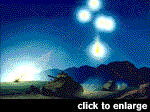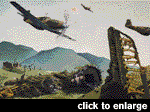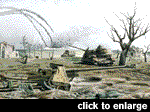





War Paintings of Lawren P. Harris |


|
The Second World War Paintings of Lawren P. Harris 1910-)by Laura BrandonCanadian Military History Vol. 2, No. 2 (Autumn 1993), 28-32.The son of Group of Seven artist Lawren S. Harris, and trained in Boston at the Museum School of Fine Arts, Lawren P. Harris was encouraged to become an official war artist by the Canadian High Commissioner to Great Britain, Vincent Massey. The family connection of both to the Massey-Harris agricultural equipment firm was a factor in their initial encounters. * Harris served with the Governor General's Horse Guards (3rd Canadian Armoured Reconnaissance Regiment) during the first three years of the Second World War. As a war artist he remained with them as part of the 5th Armoured Division in Italy during 1944. Most of his war landscapes depict tanks in the spectacular hilly landscape near the Melfa and Liri Rivers and towards Ortona. A majority of Harris' paintings are watercolours, a medium he was not, in fact, comfortable with, considering himself an oil painter.*2 Many of the watercolours were composed on relatively small sheets of paper and the artist's characteristically careful and detailed application of paint gives them a jewel-like quality. This effect is enhanced by the glowing purity of the colours he used. To this day, the small watercolours retain the freshness that was theirs at the time they were painted and amply discount Harris' perceptions at the time of his worth as a watercolourist. |
 |
Although Harris admired the fluid brush work of fellow war artists such as Will Ogilvie and Charles Comfort, his own style has significant precursors in the 18th and l9th century English watercolour school: the work of John Sell Cotman springs to mind. Cotman also worked on a small scale, and demonstrated what the medium could achieve in terms of drama and intensity in carefully worked small scale compositions. Harris' oil paintings are generally based on his watercolours and were completed after he returned to England. However, he often combined a number of watercolour images on one canvas so as to create a more complex composition--a "composite" as he called it.*3 Melfa River Crossings (cn 12704) [inside front cover] is a particularly fine example of a small Harris watercolour later used as the basis for an oil painting. Only 9" by 10", the landscape predominates. To the right can be seen the tiny image of a damaged Sherman tank. Notes on the back of the painting indicate that Highway No . 6 runs parallel to the base of the mountains and that the town of Roccasecca can be seen in the left middle distance. This watercolour is incorporated into a larger oil painting of the same title (cn 12705). |

|
Battleground near Ortona (cn 12657)1 a large oil on canvas, some four feet square, is based on a small watercolour approximately 11" by 15" in size entitled German Anti-Tank Position (cn 12687). In the oil painting, the destroyed tree to the right of the composition is simplified, as are the background details. The tank and anti-tank gun, and the rocket trails in the sky appear in both versions of the subject. The dead horse in the foreground of the oil painting is an addition to the composition.
The surreal quality of many of his pictures has been commented on in the past. Harris himself discounted this in an interview, noting that he "was doing landscapes just before the war . . . [and] they were handled the same in a kind of formalized, realistic way with clarity . . . This was my natural way of working."*4 After the war Harris ran the Fine Arts Department at Mount Allison University and his style of painting became increasingly abstract. During the war he had completed a number of oil portraits--remarkable for the dour seriousness of the sitters' expressions. He continued to paint portraits which display little of his abstract interests in the decades following. His war paintings are all housed at the Canadian War Museum in Ottawa, the watercolour images remaining amongst his most popular works.
Notes** National Archives of Canada, Joan Murray transcripts, MG 31, D142, Vol. 111, File 37, "Interview with I.Lawren P. Harris." 29 June 1979. *2 ibid. *3 ibid. *4 ibid. Back to the Top. Additional works by Lawren P. Harris are featured in this issue of CMH. Inside the back cover can be found Gunfire, Artillery Ranges; Wales, September 1943 and on page 48 is Scout Cars in Harbour. |

    
|


